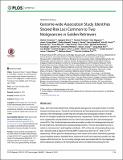Genome-wide Association Study Identifies Shared Risk Loci Common to Two Malignancies in Golden Retrievers
Author(s)
Tonomura, Noriko; Elvers, Ingegerd; Thomas, Rachael; Megquier, Kate; Turner-Maier, Jason; Howald, Cedric; Sarver, Aaron L.; Swofford, Ross; Frantz, Aric M.; Ito, Daisuke; Mauceli, Evan; Arendt, Maja; Noh, Hyun Ji; Koltookian, Michele; Biagi, Tara; Fryc, Sarah; Williams, Christina; Avery, Anne C.; Kim, Jong-Hyuk; Barber, Lisa; Burgess, Kristine; Karlsson, Elinor K.; Azuma, Chieko; Modiano, Jaime F.; Breen, Matthew; Lindblad-Toh, Kerstin; Lander, Eric Steven; ... Show more Show less
Downloadtonomura-2015-genome-wide association.pdf (905.0Kb)
PUBLISHER_CC
Publisher with Creative Commons License
Creative Commons Attribution
Terms of use
Metadata
Show full item recordAbstract
Dogs, with their breed-determined limited genetic background, are great models of human disease including cancer. Canine B-cell lymphoma and hemangiosarcoma are both malignancies of the hematologic system that are clinically and histologically similar to human B-cell non-Hodgkin lymphoma and angiosarcoma, respectively. Golden retrievers in the US show significantly elevated lifetime risk for both B-cell lymphoma (6%) and hemangiosarcoma (20%). We conducted genome-wide association studies for hemangiosarcoma and B-cell lymphoma, identifying two shared predisposing loci. The two associated loci are located on chromosome 5, and together contribute ~20% of the risk of developing these cancers. Genome-wide p-values for the top SNP of each locus are 4.6×10-7 and 2.7×10-6, respectively. Whole genome resequencing of nine cases and controls followed by genotyping and detailed analysis identified three shared and one B-cell lymphoma specific risk haplotypes within the two loci, but no coding changes were associated with the risk haplotypes. Gene expression analysis of B-cell lymphoma tumors revealed that carrying the risk haplotypes at the first locus is associated with down-regulation of several nearby genes including the proximal gene TRPC6, a transient receptor Ca2+-channel involved in T-cell activation, among other functions. The shared risk haplotype in the second locus overlaps thevesicle transport and release gene STX8. Carrying the shared risk haplotype is associated with gene expression changes of 100 genes enriched for pathways involved in immune cell activation. Thus, the predisposing germ-line mutations in B-cell lymphoma and hemangiosarcoma appear to be regulatory, and affect pathways involved in T-cell mediated immune response in the tumor. This suggests that the interaction between the immune system and malignant cells plays a common role in the tumorigenesis of these relatively different cancers.
Date issued
2015-02Department
Massachusetts Institute of Technology. Department of BiologyJournal
PLOS Genetics
Publisher
Public Library of Science
Citation
Tonomura, Noriko, Ingegerd Elvers, Rachael Thomas, Kate Megquier, Jason Turner-Maier, Cedric Howald, Aaron L. Sarver, et al. “Genome-Wide Association Study Identifies Shared Risk Loci Common to Two Malignancies in Golden Retrievers.” Edited by Tosso Leeb. PLoS Genet 11, no. 2 (February 2, 2015): e1004922.
Version: Final published version
ISSN
1553-7404